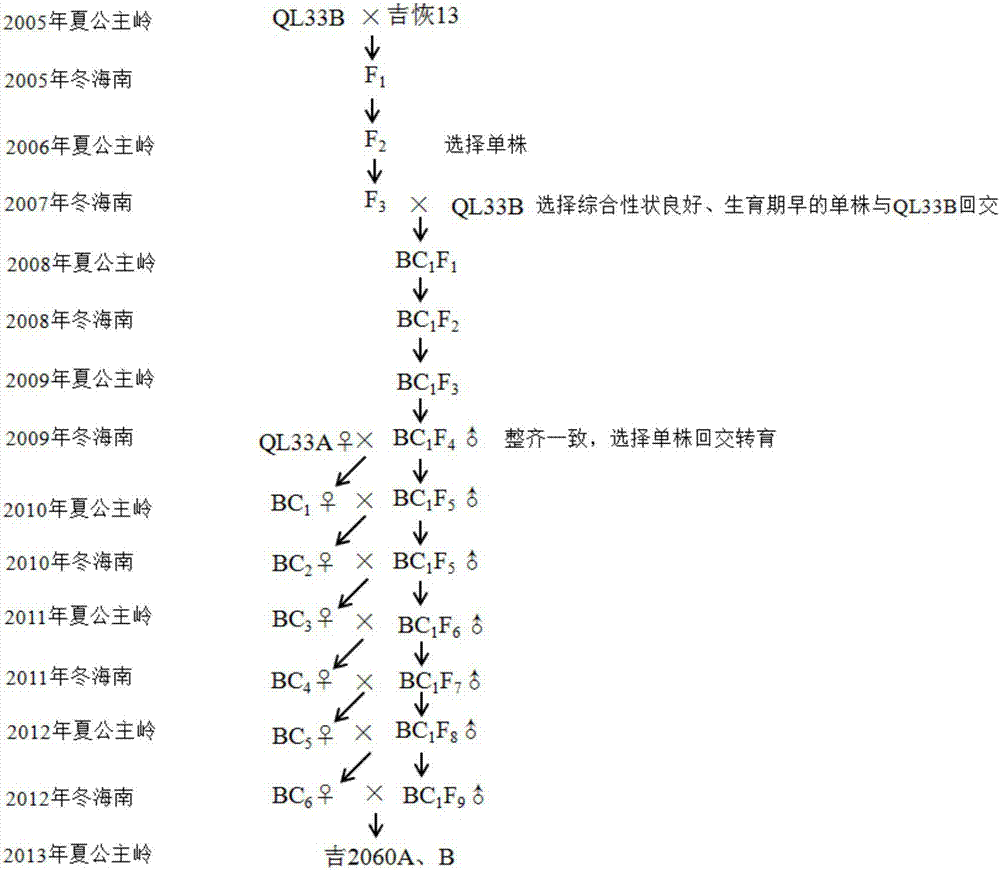Method used for seed selection of sorghum sterile lines
A technology for sterile lines and varieties, applied in the field of crop genetics and breeding, can solve the problems such as the difficulty of improving the yield and disease resistance of hybrids, the limited genetic foundation of sterile lines, and the difficulty in breaking through the utilization mode of hybrid advantages, etc. The stability of hereditary traits is strong, the plants are short, and the effect of expanding the scope of resource utilization
- Summary
- Abstract
- Description
- Claims
- Application Information
AI Technical Summary
Problems solved by technology
Method used
Image
Examples
Embodiment 1
[0040] Example 1, Breeding Sorghum CMS Line Ji 2060A
[0041] In this example, the hybridization of the maintainer line and the restorer line is used, and then backcrossing is used to select the sterile line Sorghum Ji 2060A. The specific breeding process is as follows: figure 1 shown.
[0042] Such as figure 1 As shown, in 2005, the maintainer line QL33B was used as the female parent, and the restorer line Jihui 13 (Feiteruite×Xizangbai×Hei 30B) was used as the male parent through artificial emasculation and self-crossing for 2 consecutive generations. 3 Among them, select a single plant with short plant height (60cm), compact plant type, good comprehensive traits, and early growth period to backcross with QL33B, and then continuously self-cross for three generations. 1 f 4 Among them, a single plant with short plant height, compact plant type and early growth period was selected to be backcrossed with the sterile line QL33A to produce a sterile line. After 6 generations o...
Embodiment 2
[0044] Example 2, Trait Advantages of Sorghum CMS Line Ji 2060A
[0045] The Ji 2060A male sterile line bred by the above-mentioned embodiment has a growth period of 110 days, a plant height of 60 cm, and a compact and uniform plant type; the planting density is 25-30 plants per square meter, the yield per mu is 400 kg, and the seed production yield is high. .
[0046] From the above experimental results, it can be seen that compared with other sterile lines, the sterile line Ji 2060A selected by the method for breeding sorghum sterile lines provided by the present invention has a short growth period, short plants, and attainable The degree of secret planting is high, the yield per mu is high, and the stability of genetic traits is strong.
Embodiment 3
[0047] Example 3. Comparison test of cold tolerance in germination stage of sorghum male sterile line Ji 2060A
[0048] 75 seeds with the same size and full grains were selected for each material. Disinfect with 1g / L mercuric chloride solution for 10 minutes, then rinse with tap water for 3 times and deionized water for 3 times. Arrange evenly and neatly in a 9cm petri dish with a cover covered with 2 layers of filter paper, add 8ml of water, place 3 petri dishes for each material, and 25 seeds in each incubator. Put them into an incubator at a temperature of 4°C and culture them in the dark for 5 days. On the 6th day, the temperature was increased to 15°C, and the time required for germination and the germination rate were observed. The results showed that the germination time of Ji 2060A was 5 days, and the germination rate was 80%, and the germination time of 4190A was 8 days, and the germination rate was 50%.
[0049] From the above experimental results, it can be seen ...
PUM
 Login to View More
Login to View More Abstract
Description
Claims
Application Information
 Login to View More
Login to View More - R&D
- Intellectual Property
- Life Sciences
- Materials
- Tech Scout
- Unparalleled Data Quality
- Higher Quality Content
- 60% Fewer Hallucinations
Browse by: Latest US Patents, China's latest patents, Technical Efficacy Thesaurus, Application Domain, Technology Topic, Popular Technical Reports.
© 2025 PatSnap. All rights reserved.Legal|Privacy policy|Modern Slavery Act Transparency Statement|Sitemap|About US| Contact US: help@patsnap.com

